The Microsoft Surface Book 2 (15-Inch) Review: Second Time's The Charm
by Brett Howse on December 21, 2017 8:00 AM EST- Posted in
- Laptops
- Microsoft
- Surface
- Pascal
- Surface Book
- Kaby Lake Refresh
Display Analysis
One area where Microsoft has consistently outperformed the competition is in the display department. They continue to be the only major PC maker to hardware calibrate their displays at the factory, across the entire product lineup. It wasn’t always the case, but starting with the Surface 3, all Surface devices are now calibrated, and the Surface Book 2 is of course no exception.
The benefit of a hardware calibration over something you could do on your own is that you avoid issues with clipping the display to correct issues, and of course the other benefit is the display is the right color without any work involved by the end user.
For the Surface Book 2, the 13.5-inch model keeps the same 3000x2000 3:2 aspect ratio display as the original, and that’s not a bad thing, since it was arguably the best display we’ve tested in a notebook to date. For the larger 15-inch model, the aspect ratio stays the same, but you get a few more pixels at 3240x2160. The overall density is slightly less than the smaller Book, but the difference is small. The 13.5-inch model is 267 PPI, and the 15-inch model is 258 PPI.
Microsoft also has started to add some rudimentary color management tools for the end user, with selectable color profiles in the action center. They started this trend with the Surface Studio, which is the only Surface model to date which supports the wider color gamut of DCI-P3 and P3-D65, but it also has a profile for sRGB, which is what most of the web and applications use. While it would be nice to see P3-D65 gamut support on the other Surface devices as well, there are power implications of wider gamut LEDs, and the lack of a true color management system in Windows means it’s generally best to leave the system in sRGB mode anyway.
With both the new Surface Pro, and the Surface Book, to offer some of the P3-D65 benefits but with the constraints of a sRGB panel, Microsoft provides an Enhanced mode which offer mid-tones closer to P3-D65 without affecting skin tones. That gives you a bit more pop in the colors without blowing out skin tones, and is the default color mode on the Surface Book 2. It’s not the same as a true P3-D65 display by any means, but for people who feel sRGB is a bit too dull for them, it’s a way to keep those users happy as well.
To look at the Surface Book 2’s display characteristics, we utilize SpectraCal’s CalMAN suite, along with an X-Rite i1DisplayPro colorimeter for contrast and brightness readings, and the X-Rite i1Pro2 spectrophotometer for color accuracy.
Brightness and Contrast
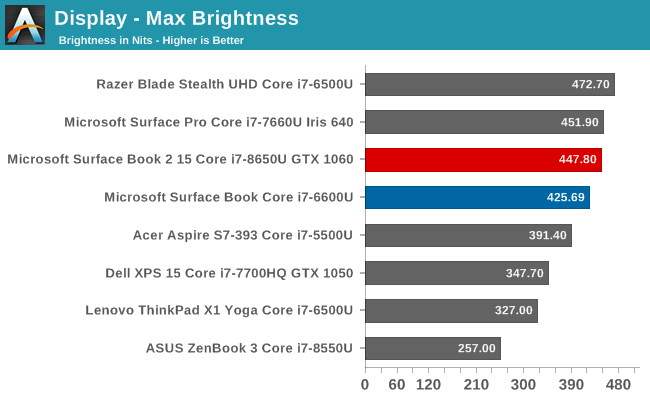
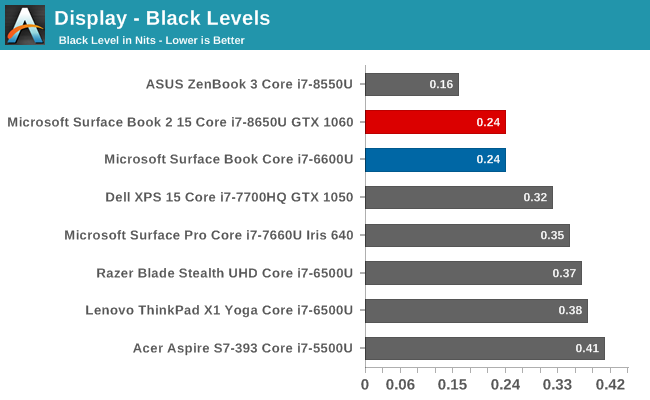
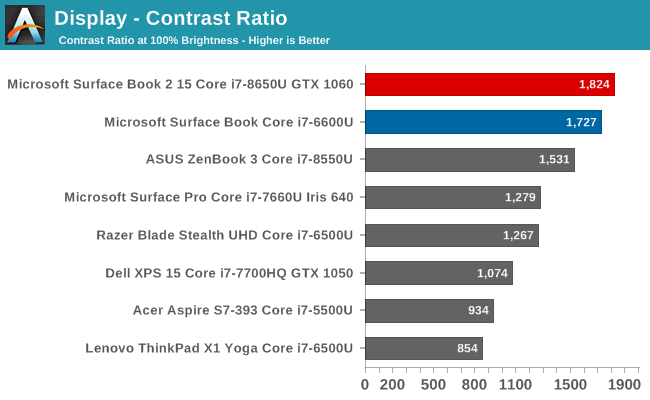
The larger Surface Book 2 gets plenty bright, and about 450 nits, which will help if using in a bright environment or outside. But despite these very bright whites, the black levels are still very solid, leading to excellent contrast. This was one of the best things about the original Surface Book, and the black levels really help out in video content.
For those that want to use the Surface Book 2 in a dim room, the display goes all the way down to 4 nits, so there is plenty of brightness range to find a level suitable for anyone.
Grayscale

Thanks to the factory calibration, the Surface Book 2 offers exceptional grayscale results. The overall dE2000 is by far the best we’ve ever tested. The gamma levels stay pretty close to the 2.2 level, as they should. Unlike some devices where great grayscale on the black levels helps drive the average down for poor grayscale at 100% white, the Surface Book 2 is almost perfect across the entire range, with no level exceeding a dE2000 of 2.0. The white point is perfect as well.
Gamut
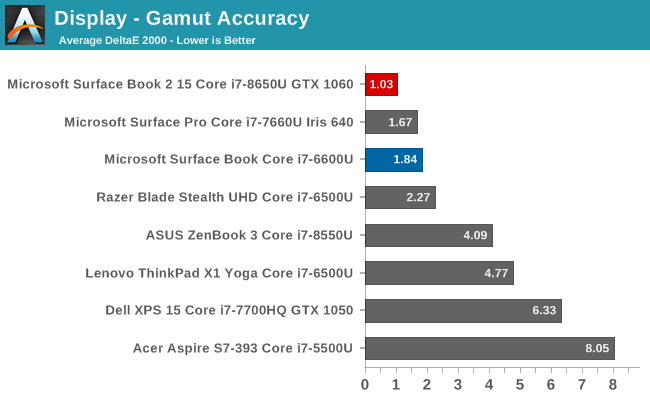
The gamut results mirror the grayscale, in that they are almost perfect for both the primary and secondary colors. Only 100% blue is slightly off, which drags cyan off a bit as well, but the error levels are so small it would be difficult to detect them with the human eye.
Saturation
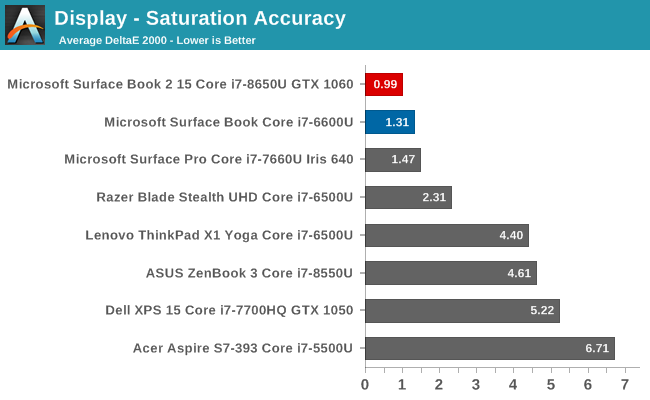
Rather than just test the 20% levels, we now do a full 4-bit step for saturation. The Surface Book 2 has an overall dE2000 level under 1 for this test, which is exceptional.
Gretag Macbeth
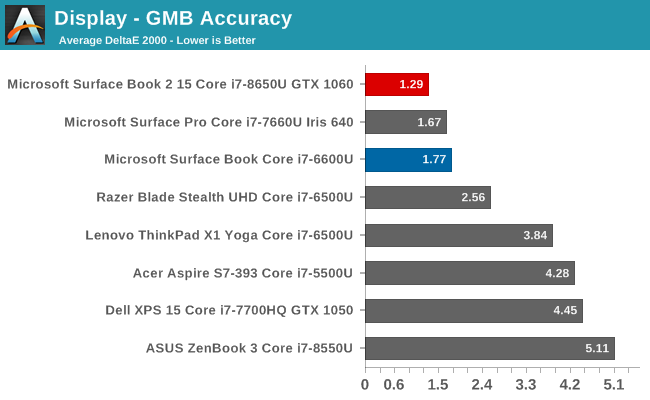
The Gretag Macbeth test covers far more colors, and is the most comprehensive test. It includes the important skin tones as well. The overall result for the Surface Book 2 is once again, fantastic. A few colors drift slightly, but very few even creep over the 2.0 error level.
In addition, we run a colorchecker test to provide a relative comparison of the correct color that should be displayed on the bottom, along with the color that is actually displayed on top. The result is relative though due to error levels in your own display, but you can see that the Surface Book 2 has white and color levels that are nearly perfect.
Enhanced Mode
Turning on Enhanced Mode changes the gamma and uses hardware to shift the colors for some colors, without affecting the skin tones.
You can see the gamma is off quite a bit compared to the 2.2 level it should hit, compared to the nearly perfect gamma in sRGB mode. The overall grayscale levels are still far better than practically any other notebook though.
The Gretag Macbeth shows off the effect on colors. The dE2000 level is much higher on certain colors, but the skin tones remain unchanged. But even so, with a GMB result under 2.0, even in enhanced mode the color accuracy is far better than almost any other notebook.
Display Conclusion
Microsoft continues to be the only major PC maker to color calibrate all of their devices, and the Surface Book 2 sets new levels for accuracy in a notebook. The display also has amazing contrast. It’s not difficult to add these together and say that the Surface Book 2 has the best display on any laptop.


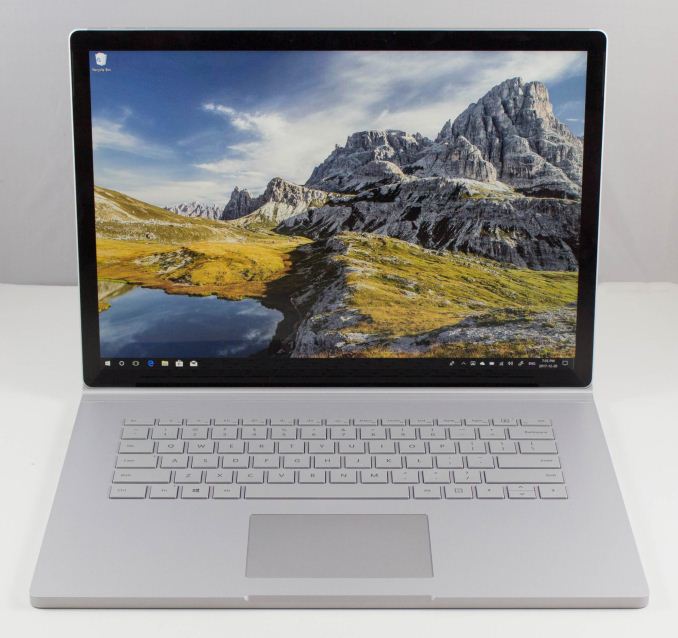
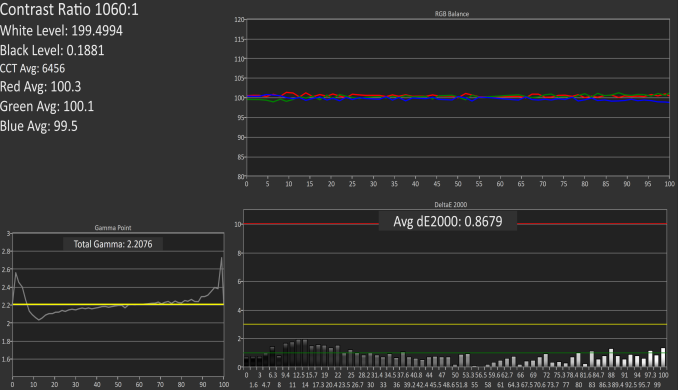

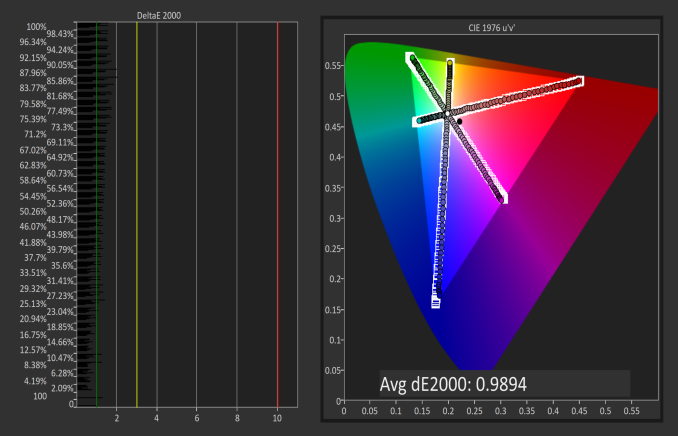



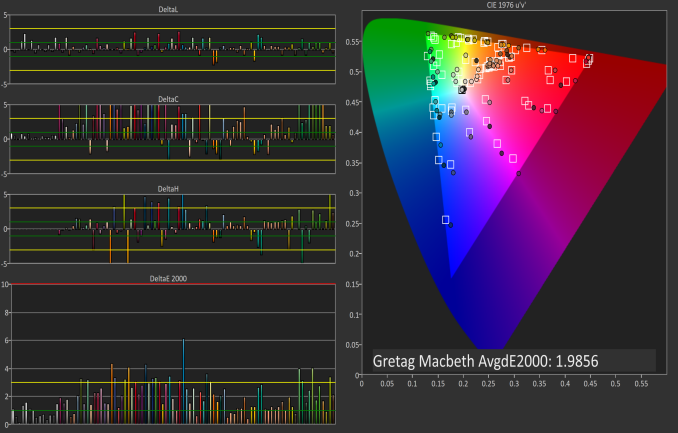








120 Comments
View All Comments
Daniel Egger - Tuesday, January 2, 2018 - link
Then make the functions switchable in the BIOS.The reality (after taking off the corporate tinfoil hat) is: If you have physical access to a device, you can take it over -- TB or not.
id4andrei - Thursday, December 21, 2017 - link
Maybe Windows telemetry makes MS comfortable in avoiding TB. Pushing people towards their standardized dock is also a plausible reason. A USB-C/TB charging standard is not something "must have" in the real world. In the case of the Surface Studio it's also about dictating a use case.Also, Ryzen and ARM laptops are starting to emerge. TB is essentially an Intel proprietary solution. Would lack of TB on those be considered downsides?
HStewart - Thursday, December 21, 2017 - link
Thunderbolt is an open standard you can not blame Intel on this - Ryzen and ARM are minimum impact on laptop businessMicrosoft is just slow to going to standards - it took them forever to get USB-C Thunderbolt 3 is just a superset of USB-C standard.
Reflex - Thursday, December 21, 2017 - link
Thunderbolt is a proprietary Intel standard. It has high licensing fees and Intel has not opened it up or permitted third party implementations to this date. They have announced that they will do so for manufacturers (but not necessarily competing chip providers) in 2018. It also has a high cost to implement.More details here -
https://arstechnica.com/gadgets/2013/01/with-licen...
https://www.bit-tech.net/news/tech/peripherals/int...
thunderboltComment - Friday, December 22, 2017 - link
Thunderbolt went royalty free in May.https://www.extremetech.com/computing/249902-thund...
thunderboltComment - Friday, December 22, 2017 - link
Ah, I see the second article now. ThanksReflex - Friday, December 22, 2017 - link
I am going to be very curious if the new 'royalty free' status is available to all or only whom Intel deems worthy. Royalty free does not mean 'open', the IP owner can still determine who gets to use it. AMD could still be locked out, but we will see.ddrіver - Saturday, December 23, 2017 - link
TB may be open but only since this year. And manufacturing is still exclusively Intel until 2018. So check back next year.damianrobertjones - Friday, December 22, 2017 - link
"The Surface Connector never took off" - Did it have to take off?Isn't the lack of TB3 blah blah due to the pcie lanes being offered?
Frenetic Pony - Thursday, December 21, 2017 - link
And a better display. The newer Ipad pro has a 120hz HDR display for a third the cost of this thing. It's honestly what made me skip it despite the fact that my SP3 is really starting to creak and groan.